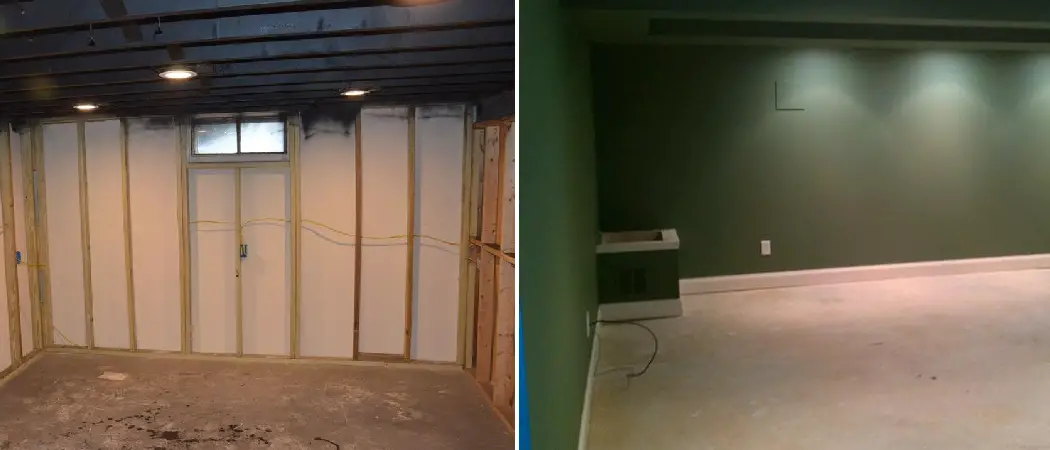Do you have a sump pump in your basement that takes away excess water and prevents flooding? Does it look unsightly and disrupt the aesthetic of your finished space? Well then, you’re in the right place because we’re here to show you how hiding a sump pump can help give your finished basement an even better finishing touch.
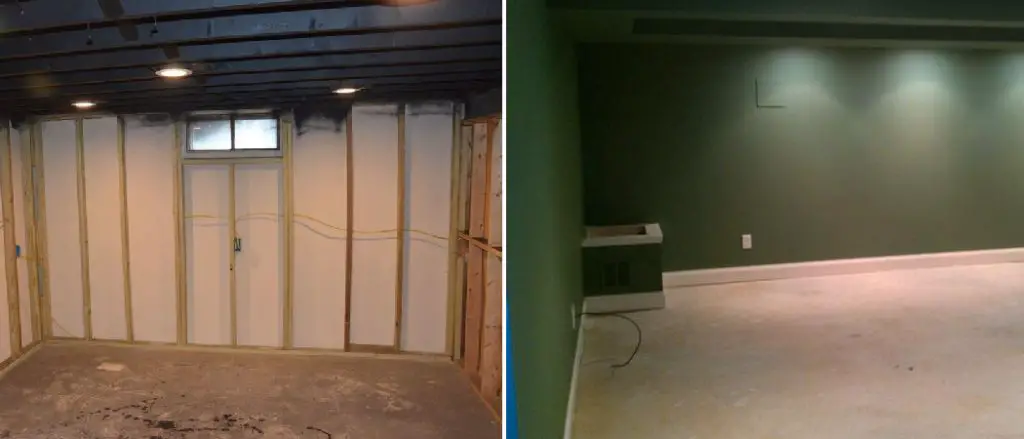
Luckily, there are several simple solutions that don’t require much time or money to conceal the system. Here, we’ll break down step-by-step instructions on how to hide a sump pump in a finished basement and why this is important for protecting both your home and its contents.
From masonry work to enclosure systems, get ready to discover easy solutions so you can create an attractive space while ensuring the best protection from potential floods.
Understanding Sump Pumps
Before we delve into how to hide your sump pump, it’s important to understand what a sump pump is and why we need it. A sump pump is a device installed in some homes to help prevent flooding. It’s typically placed in the lowest part of the basement or crawl space. Its job is to help keep the area under the building dry and prevent it from flooding. Water flows into the sump pit through drains or naturally through the soil, and the sump pump pumps the water out of the pit and away from the building to keep the basement dry.
There are two primary types of sump pumps: pedestal and submersible. The pedestal pump’s motor is mounted above the sump, where it is more easily serviced but also more visible. The submersible pump is entirely contained within the sump and is specially sealed to prevent electrical short circuits.
Proper maintenance and location are crucial for the effective operation of a sump pump. Maintenance includes regularly checking the pump for debris and testing it to ensure it turns on when the water level rises. The location should be a dry, cool space where it won’t freeze and where you can easily access it for maintenance.
Why Do You Need to Hide a Sump Pump in A Finished Basement
While hiding a sump pump in a finished basement is not a necessity, many homeowners choose to do so for a couple of reasons:
1. Aesthetics:
A finished basement is often designed to be an inviting and visually appealing space. The presence of a sump pump, with its exposed pipes and utilitarian appearance, can disrupt the overall aesthetic and feel of the room. By concealing the sump pump, you can maintain a cohesive design and ensure that the basement looks as intended.
2. Preservation of Space:
Basements are often utilized as multifunctional spaces, serving as living areas, home theaters, offices, or recreational rooms. Having a sump pump in plain view might limit your options for furniture placement and room arrangement. By hiding the sump pump, you can maximize the usable space and create a more versatile environment.
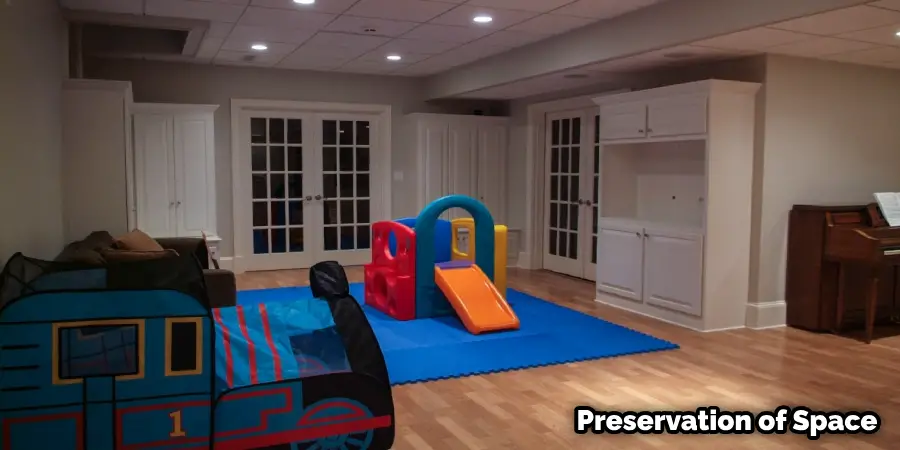
It’s worth noting that while hiding a sump pump can enhance the visual appeal of your basement, it’s crucial to balance aesthetics with practicality. Easy access to the sump pump for maintenance and repairs should always be a priority.
Factors to consider
1. Location:
The first and most important factor to consider when hiding a sump pump is its location. You want to make sure that the pump remains easily accessible for maintenance, repairs, and testing. Therefore, it’s essential to choose a location that is still relatively easy to reach and not hidden behind bulky furniture or walls.
2. Material and Design:
When it comes to hiding a sump pump, there are several options for materials and designs. You can choose to conceal the pump with a custom-built enclosure made from wood, drywall, or other materials. Alternatively, you can opt for pre-made enclosure systems that are specifically designed for sump pumps.
3. Ventilation:
Proper ventilation is essential when hiding a sump pump. Ensure that the enclosure or system you choose allows for proper air circulation to prevent overheating and potential damage to the pump.
4. Maintenance:
As mentioned earlier, easy access for maintenance is crucial for a sump pump’s effective operation. When choosing an enclosure or system, make sure it has removable panels or other features that allow for easy access to the pump.
5. Cost:
The cost of hiding a sump pump can vary depending on the materials and design chosen. While custom-built enclosures may be more expensive, they offer flexibility in terms of design and customization. Pre-made enclosure systems tend to be more affordable but are limited in terms of design options.
8 Ways on How to Hide a Sump Pump in A Finished Basement
1. Place the Sump Pump in Its Own Enclosure:
The most straightforward way to hide a sump pump is to build an enclosure around it. This can be done using cabinet-grade plywood, which is an affordable option for concealing the pump while still providing easy access for maintenance and repairs. The box should be built with adequate. Ventilation holes to prevent the unit from overheating and ensure it runs properly.
2. Choose an Appropriate Color for the Enclosure:
Choosing a color that complements your basement décor when building an enclosure around your sump pump is essential. If you have light-colored walls, opt for a neutral hue such as white or light gray. For darker colors, a darker shade of the same color can help blend in with the room’s overall palette.
3. Build a Cabinet Around It:
A slightly more involved approach for hiding your sump pump is to build an attractive cabinet around it. This will not only keep the equipment out of sight but also provide extra storage space. When building the cabinet, make sure to include adequate ventilation holes for proper airflow and cooling.
4. Place the Sump Pump in an Unused Corner:
If you want a low-effort solution for hiding your sump pump, consider placing it in an unused corner of the basement. This may be your best option if you don’t have the time or resources to build a cabinet or enclosure around it. Keep in mind that this approach will require some rearranging of furniture and other items in the room to make sure no one ever notices the sump pump.
5. Cover It with a Rug or Tapestry:
If you don’t want to go through the effort of building an enclosure or cabinet for your sump pump, a simple solution is to cover it with a rug or tapestry. There’s no need to invest in expensive decorating materials; simply use whatever you have at home. This will not only hide the sump pump but also add an elegant touch to your basement.
6. Install a Fake Wall:
If you want to go the extra mile when it comes to concealing your sump pump, consider installing a fake wall around it. This involves creating a false wall out of drywall and framing material, which you can then paint or wallpaper in a way that matches the rest of your basement. This approach is sure to completely conceal the sump pump while also making your space look stylish and inviting.
7. Create a Fake Floor:
If you don’t have the time or budget to install a false wall, another option is to create a fake floor over the sump pump. This can be done by constructing a wooden frame around the pump and covering it with appropriate flooring material, such as tile or vinyl flooring. Then all you need to do is arrange furniture and rugs in a way that hides the sump pump completely.
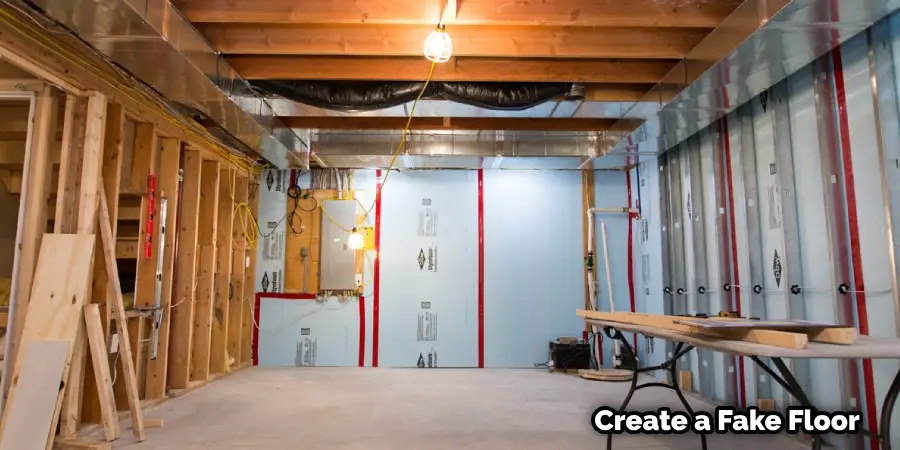
8. Plant Greenery Around It:
If you don’t care about easy access to the sump pump for maintenance and repairs, you could also consider hiding it by planting greenery around it. This solution is ideal if your basement has a lot of natural light and you want to create a garden-like atmosphere. Place tall plants or shrubs around the sump pump to completely conceal it while adding an aesthetic touch to the space.
By following these tips, you can easily hide your sump pump in a finished basement without compromising on its functionality or aesthetics. With a bit of creativity and some effort, you’ll be able to make sure that your sump pump is out of sight and still working properly.
Creative and Unexpected Ideas
Furniture Integration:
One innovative and practical way to hide a sump pump is by integrating it into your furniture. This can be achieved by using an ottoman or coffee table with a removable top, under which the pump is concealed. Not only does this make your pump virtually invisible, but it also adds functionality and style to your basement. However, the weight capacity of the furniture must be taken into consideration, and the design needs careful planning to ensure easy access for maintenance and repairs.
Water Feature Disguise:
This idea not only hides your sump pump but also adds a unique and attractive feature to your decor. By disguising the sump pump under a small fountain or waterfall, you can mask the noise and add a calming ambiance to your basement. Keep in mind that this method requires some plumbing modifications and ongoing maintenance.
Art Installation:
For the artistically inclined, transforming the sump pump into a part of a custom artwork or sculpture can be an expressive and personalized solution. This approach hides everything seamlessly and can even become a conversation starter among your guests. However, it requires a certain level of artistic vision and skill, and could potentially be an expensive option depending on the art materials used.
6 Common Mistakes People Might Make While Hiding Sump Pump in A Finished Basement
1. Not Allowing for Proper Ventilation:
It’s essential to make sure that the sump pump has adequate airflow and cooling. If not, it could overheat and malfunction, leading to costly repairs or replacements in the future.
2. Placing It Too Close to Walls:
Placing the sump pump near a wall can block its ventilation holes, so make sure that there’s a decent amount of space between the pump and any walls.
3. Not Considering Access:
If you cover the sump pump completely, it may be difficult to access when maintenance or repairs are needed. Consider leaving an opening on one side for easy access when necessary.
4. Overlooking Electrical Requirements:
Before hiding the sump pump, make sure that the electrical wiring is up to code and there are no safety hazards, such as exposed wires or loose connections.
5. Not Thinking of Drainage Issues:
Make sure you place the sump pump in an area where it won’t be blocked by furniture or other items and can drain properly.
6. Not Considering the Temperature:
Avoid placing the sump pump in areas where they may be exposed to extreme temperatures, such as in direct sunlight or next to a heat source. This could lead to malfunctions over time.
By paying close attention to these details, you can avoid costly mistakes when hiding your sump pump in a finished basement. With the right planning and preparation, you’ll be able to effectively conceal the pump while also avoiding any potential issues down the road.
Maintenance Tips
1. Check for Leaks:
Periodically check the sump pump for any signs of leakage or water damage. If you see any, contact a professional plumber right away to repair it.
2. Clean Out Debris:
Make sure to clean out the area around the sump pump regularly to avoid clogs or other blockages.
3. Test Regularly:
Test the sump pump periodically to make sure it’s working properly and can handle any water that accumulates in the area.
4. Inspect the Discharge Line:
Check the discharge line regularly for blockages or clogs, which may be caused by debris, dirt, or sediment buildup.
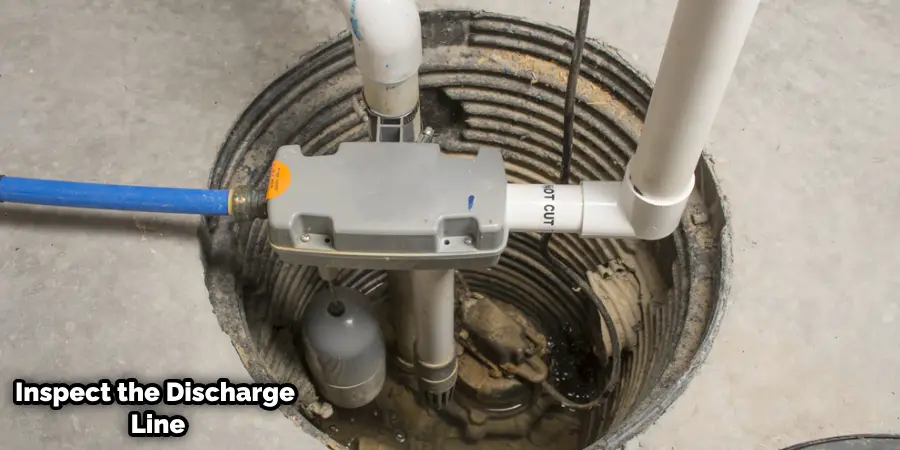
5. Perform Maintenance According to Manufacturer’s Instructions:
Always consult the manufacturer’s instructions for maintenance and repairs to ensure your sump pump is running optimally.
By following these tips, you can extend the life of your sump pump and make sure it’s working properly. With proper maintenance, you’ll be able to enjoy a dry basement and hide your sump pump successfully.
Safety Guidelines for Installing Sump Pump in a Finished Basement
Tip 1: Wear the Appropriate Safety Equipment
Always wear the appropriate safety equipment when handling any electrical wiring or plumbing. This includes rubber gloves and protective eyewear.
Tip 2: Know Your Electrical Requirements
Make sure you know the local electrical requirements for installing a sump pump. This may include obtaining a permit or having an electrician inspect and install the wiring.
Tip 3: Don’t Overload Circuits
When connecting the sump pump to power, make sure not to overload the circuit. This is especially important if you’re using a backup power source, such as a battery.
Tip 4: Read Instructions Carefully
Before starting any installation or repair work on the sump pump, make sure to read all instructions carefully. This will help ensure that everything is done correctly and safely.
Tip 5: Contact a Professional
If you’re not sure how to install or repair the sump pump, contact a professional plumber or electrician for help. They will be able to do the job safely and efficiently.
By following these safety guidelines, you can ensure that your sump pump is installed correctly and safely in your finished basement. With proper installation and maintenance, you’ll be able to keep your finished basement dry and hide the sump pump from view.
Tips for Decorating Around a Hidden Sump Pump
1. Keep it Simple:
The key to decorating around a hidden sump pump is to keep things simple and minimalistic. Avoid cluttering the area with too many things, and opt for furniture pieces that are easy to move around.
2. Use Light Colors:
Light colors can help make the area appear larger and brighter while also softening the contrast of the sump pump. Opt for neutral colors like white, off-white, pastels, or muted hues to keep the focus away from the pump.
3. Add Textures:
Using different textures in the design can help draw attention away from the sump pump while adding visual interest to the area. Choose items like rugs, throw pillows, or wall hangings with interesting patterns and textures for a subtle yet stylish look.
4. Make Use of Wall Space:
Take advantage of the wall space to create a focal point and draw attention away from the sump pump. Hang a large piece of artwork, display shelves, or use mirrors to make the area appear larger.
5. Incorporate Greenery:
Adding some greenery is an easy way to spruce up any area in your finished basement, including hiding a sump pump. Use potted plants to add some pops of color and life to the area while also concealing the sump pump from view.
By following these tips, you can easily and effectively decorate around a hidden sump pump in your finished basement. With careful planning and thoughtful design choices, you’ll be able to keep your finished basement looking stylish and sophisticated.
Cost Considerations for Hiding a Sump Pump in a Finished Basement
1. Budgeting for Materials and Labor:
When planning to conceal a sump pump in a finished basement, it’s crucial to budget for the necessary materials and labor. The materials required may include aesthetic additions such as cabinetry or a decorative cover, as well as functional elements like piping or wiring. Labor costs can vary greatly, particularly if professional help is enlisted for electrical work or carpentry. Always seek multiple estimates to ensure you’re getting the best price and quality of work.
2. Tips for Cost-Saving Options:
There are several ways to cut costs when hiding a sump pump. Consider DIY options for decorative elements or repurpose existing furniture to conceal the pump. This can significantly reduce the cost of materials. Additionally, shopping sales or utilizing reclaimed materials can further slash your expenses. Moreover, learning to perform simple maintenance tasks yourself can save on future labor costs.
3. Calculating the Return on Investment for a Hidden Sump Pump:
The return on investment (ROI) for a hidden sump pump can be calculated in several ways. By protecting your finished basement from potential water damage, you’re potentially saving thousands in repair costs. Furthermore, a well-hidden sump pump enhances the aesthetic appeal of your basement, which could boost the overall value of your home if you ever decide to sell. To calculate the ROI, estimate the total costs saved and compare it to the initial investment of hiding the sump pump.
Legal and Code Compliance for Hiding a Sump Pump
1. Checking Local Building Codes and Regulations:
Before concealing a sump pump in a finished basement, it is crucial to check your local building codes and regulations. These can vary from city to city and are in place to ensure safety and functionality. Local codes may have specific requirements for sump pump installations, such as the type and size of the pump, location, discharge pipe’s placement, and other necessary safety features. Violating these codes could result in fines and potential issues when selling your home.
2. Permit Requirements for Concealing Sump Pumps:
Depending on your locale, you may need a permit to conceal a sump pump. Always check with your local permit office or building inspector before beginning the project. They can provide information about specific requirements, inspections, and any associated fees. Obtaining a permit can also provide an added level of assurance that your concealed sump pump will meet all safety standards and regulations. Not getting the required permit could lead to additional costs in the future, such as fines or having to redo some of your work to meet safety standards.
Frequently Asked Questions
Q: Will Hiding the Sump Pump Affect Its Functionality?
A: No, hiding the sump pump does not have to affect its functionality. As long as you keep it well-ventilated and make sure it has enough access for maintenance and repairs, your sump pump should be just as efficient as if it was visible.
Q: What Are Some Suitable Materials for Building a Custom Enclosure?
A: There are many suitable materials for building a custom enclosure for your sump pump, such as wood, plywood, plastic, and metal. Make sure to choose something that is both durable and easy to work with.
Q: Can I Use the Sump Pump for Other Purposes?
A: Yes, you can use the sump pump for other purposes. However, it’s important to make sure that the pump is rated for the job and that the extra water flow won’t overload it. Consult a professional if you have any questions or concerns about using your sump pump for more than just draining your basement.
Q: How Often Should I Test My Sump Pump?
A: It’s a good idea to test your sump pump every 6-12 months, or more frequently if you live in an area that receives a lot of heavy rain. This will help ensure that the pump is functioning properly and can handle any water that accumulates. If you notice any problems, contact a professional plumber right away
Conclusion
Hiding a sump pump in a finished basement is an effective way to keep the area dry without compromising its aesthetics. With careful planning and attention to detail, you can make sure that your sump pump remains out of sight but still functioning optimally.
Additionally, regular maintenance and inspections of the sump pump are essential to ensure it is running properly. With the right precautions, you can keep your basement dry and free from water damage for years to come. Thanks for reading this article about how to hide a sump pump in a finished basement.

